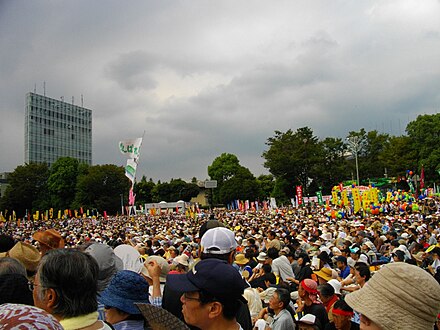Protest
A protest (also called a demonstration, remonstration or remonstrance) is a public expression of objection, disapproval or dissent towards an idea or action, typically a political one.[2][3] Protests can be thought of as acts of cooperation in which numerous people cooperate by attending, and share the potential costs and risks of doing so.[4] Protests can take many different forms, from individual statements to mass demonstrations. Protesters may organize a protest as a way of publicly making their opinions heard in an attempt to influence public opinion or government policy, or they may undertake direct action in an attempt to enact desired changes themselves.[5] Where protests are part of a systematic and peaceful nonviolent campaign to achieve a particular objective, and involve the use of pressure as well as persuasion, they go beyond mere protest and may be better described as a type of protest called civil resistance or nonviolent resistance.[6]
Various forms of self-expression and protest are sometimes restricted by governmental policy (such as the requirement of protest permits),[7] economic circumstances, religious orthodoxy, social structures, or media monopoly. One state reaction to protests is the use of riot police. Observers have noted an increased militarization of protest policing in many countries, with police deploying armored vehicles and snipers against protesters. When such restrictions occur, protests may assume the form of open civil disobedience, more subtle forms of resistance against the restrictions, or may spill over into other areas such as culture and emigration.
A protest itself may at times be the subject of a counter-protest. In such cases, counter-protesters demonstrate their support for the person, policy, action, etc. that is the subject of the original protest. Protesters and counter-protesters can sometimes violently clash. One study found that non-violent activism during the civil rights movement in the United States tended to produce favorable media coverage and changes in public opinion focusing on the issues organizers were raising, but violent protests tended to generate unfavorable media coverage that generated public desire to restore law and order.[8]
Unaddressed protests may grow and widen into civil resistance, dissent, activism, riots, insurgency, revolts, and political or social revolution. Some examples of protests include:
A protest can take many forms.[10][11]Willingness to participate is influenced by individuals' ties within social networks. Social connections can affect both the spread of factual information about a protest and social pressures on participants.[4] Willing to participate will also vary depending on the type of protest. Likelihood that someone will respond to a protest is also affected by group identification, and by the types of tactics involved.[12]
The Dynamics of Collective Action project and the Global Nonviolent Action Database[13] are two of the leading data collection efforts attempting to capture information about protest events. The Dynamics of Collective Action project considers the repertoire of protest tactics (and their definitions) to include:[14]



